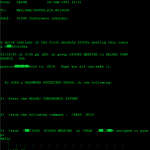Source: Byte – June 1981
Byte, subtitled ‘The Small Systems Journal’, initially covered ‘small systems’. Generally small business computer and what could be considered home computers though I think they started before that term really existed. The original IBM PC was first introduced in 1981 though I believe that was after this issue was published. The June 1981 issue of Byte includes:
Features
- Logo for Personal Computers – A preview of two upcoming implementations of the Logo language for personal computers, including TI Logo for the TI-99/4 and Apple Logo for the Apple II. Logo was developed by the Artificial Intelligence Laboratory at MIT.
- Build a Low-Cost Speech Synthesizer Interface – Instructions for building a speech synthesizer. These seemed to be all the rage in the early to mid 1980s.
- Mathematical Modeling: A BASIC Program to Simulate Real-World Systems – Simulating systems by solving a system of differential equations. This article includes lots of math along with some code.
- A Computer-Based Laboratory – This article focuses on creating accurate digital timers.
- CP/M: A Family of 8- and 16-bit Operating Systems – CP/M was the closest thing to a standard operating system that existed for personal computers before the IBM PC and DOS came along. DOS was largely based on CP/M.
- The UNIX Operating System and the XENIX Standard Operating System – UNIX was the other operating system standard but at the time, this was for larger systems. Xenix was essentially Microsoft’s implementation with enhancements.
- The Ins and Outs of CP/M – This article discusses the I/O routines of the CP/M operating system.
- Build a Super Simple Floppy-Disk Interface, Part II – The second part of an article on building your own disk controller. The first part focused on the hardware whereas this part focuses on the software (formatting, reading, writing, and error recovery).
- An Easy-to-Use A/D Converter – Instructions for creating your own A/D converter that can then be used for things like monitoring analog voltages, reading light levels, measuring temperature, etc.
- The Impossible Dream: Computing e to 116,000 Places with a Personal Computer – A method for computing e to 116,000 places. This article was written by Steve Wozniak, designer of the Apple II.
Reviews
- RAMCRAM Memory Module for the Atari – A 32K RAM expansion module for the Atari 400 for $320 (that’s the equivalent of roughly $1100 today).
- Information Unlimited: The Dialog Information Retrieval Service – An online service accessible via modem and terminal software that offered millions of references and abstracts for searching.
- Four Word Processors for the Apple II – Reviews of Super-Text II, Write-On! I and II, Datacope Scribe, and EasyWriter and EasyWriter Professional.
- Startrek 4.0 and Startrek 3.5 – Two versions of a Star Trek game for the TRS-80 Model I.
- The BDS C Compiler – A C compiler for 8080 based CP/M systems.
Nucleus
- Editorial – Commentary on 16-bit computers and user friendliness.
- Letters
- Technical Forums – LISP vs. FORTRAN, Interrupts, Votrax voice synthesizer vocabulary, and more.
- Education Forum – An approach for using microcomputers in education.
- Programming Quickie: Z80 Table Lookup – Machine language table lookup on the Z80.
- BYTELINES – Outstanding growth for Tandy sales, first computers with built-in Winchester-disk drives (hard drives), Tandy sues competitors, IBM to build Josephson computer, warranties for TRS-80 computers, and more.
- System Notes: LIST – A C program for listing source code (e.g. to a printer).
- Ask BYTE – Questions answered about remote data entry, backup power supplies, memory bank switching, opening a computer store, and more.
- BYTE’s Bits – A terminal for the vision impaired, cryptology competition, and more.
- What’s New – New line of Z-100 Z80-based microcomputer systems from California Computer Systems (CCS), new 6800 single-board computer from ACS, an 8088 microprocessor board from Acom for the S-100 bus, IEEE-488 interface for the Apple II, and much more.

…and more!



